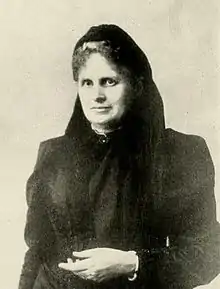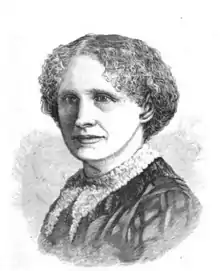Mary Hunt
Mary Hunt (1830–1906) was an American activist in the United States temperance movement promoting prohibition of alcohol. She gained the power to accept or reject children's textbooks based on their representation of her views of the danger of alcohol. On her death there were questions asked regarding the finances of the organisation.
Mary Hunt | |
|---|---|
 undated image | |
| Born | Mary Hannah Hanchett 1830 |
| Died | 1906 |
| Nationality | United States |
| Successor | Cora Stoddard |
Biography
Mary Hannah Hanchett was born in Litchfield, Connecticut in 1830. As Superintendent of the Women’s Christian Temperance Union's Department of Scientific Temperance Instruction, she worked from the grass roots to the national level to ensure passage of laws requiring that textbooks teach every school child a curriculum promoting complete abstinence for everyone and alcohol prohibition.
She achieved the de facto power to veto any such textbook of which she did not approve. Hunt sent the first of her criteria for acceptable books to publishers, who then submitted the resulting drafts to her for recommendations and possible endorsement. For example, the WCTU leader did not approve of any book that mentioned the widespread medicinal use of alcohol or any book that even implied that drinking in moderation did not inevitably lead to serious alcohol abuse.[1]

By the mid-1890s, the WCTU's program of temperance instruction and the textbooks endorsed by Mary Hunt were increasingly being criticized. The Committee of Fifty, a group formed in 1893 by scholars to study the "liquor problem",[2] was highly critical of the ideological purity demanded by Mrs. Hunt. It argued that children should not be taught "facts" that they would later find to be incorrect. The group concluded that the WCTU's program of temperance instruction was seriously defective and probably counter-productive.[3]
Mrs. Hunt prepared a reply in which she charged the Committee of Fifty with being prejudiced against abstinence instruction, criticized it for what she considered gross misrepresentation of facts, and insisted that the endorsed textbooks were completely accurate. She then had the reply entered into the Congressional Record [4] and distributed more than 100,000 copies.[5]
Although she stirred controversy, one writer noted that "by the time of her death in 1906, Mary Hunt had shaken and changed the world of education" with her campaign for mandatory temperance instruction.[6] In 1901–1902, 22 million school children were required to take Hunt-approved temperance instruction.[7] "The WCTU was perhaps the most influential lobby ever to shape what was taught in public schools. Though it was a voluntary association, it acquired quasi-public power as a censor of textbooks, a trainer of teachers, and arbiter of morality".[8]
Temperance writers viewed the WCTU's program of compulsory temperance education as a major factor leading to the Eighteenth Amendment establishing National Prohibition.[9] Other knowledgeable observers, such as the U.S. Commissioner of Education, agreed (Timberlake, 1963, p. 46). A study of legislative control of curriculum in 1925 indicated that teaching about temperance "is our nearest approach to a national subject of instruction; it might be called our one minimum essential".[10] The WCTU "laid the groundwork for the formal drug education programs that remain high on the agendas of today",[11] and some of the laws for which Mrs. Hunt lobbied so persistently still remain.[12]
Controversy followed Mary Hunt even after her death. In order to deal with the accusation that she profited from her position and power, Mary Hunt had signed over to charity the royalties due her on the thousands of temperance textbooks sold annually. Her never-publicized charity was the Scientific Temperance Association, a group composed of Hunt, her pastor, and a few friends. Hunt's secretary Cora Stoddard took over the leadership of the organisation.[13] The association used its funds to support the maintenance of the national headquarters of the WCTU's Department of Scientific Temperance Instruction, a large house in Boston that was also Mrs. Hunt's residence.[14]
Selected works
- Hunt, Mary H. A History of the First Decade of the Department of Scientific Temperance Instruction in Schools and Colleges. Boston, MA: Washington Press, 1892.
- Hunt, Mary H. An Epoch of the Nineteenth Century: An Outline of the Work for Scientific Temperance Education in the Public Schools of the United States. Boston, MA: Foster, 1897.
- Hunt, Mary H. Reply to the Physiological Subcommittee of the Committee of Fifty. Boston: Woman’s Christian Temperance Union, 1904. See also 58th Congress, 2d Session. Senate. Document No. 171.
- Hunt, Mary Hannah Hanchett Hunt. In: Garraty, John A. and Cames Mark C. (eds) American National Biography. N.Y.: Oxford University Press, 1999, vol. 11, pp. 498–499.
References
- (Bader, 1986, p. 99).
- (Fumas, 1965, p. 330)
- (Billings, et al., 1905).
- (Hunt, 1904)
- (Mezvinsky, 1959, p. 184).
- (Ohles, 1978, p. 478).
- (Hunt, 1904, p. 23).
- (Tyack and James, 1985, p. 519)
- (Cherrington, 1920, p. 175).
- (Tyack and James, 1985, p. 516; also see Flanders, 1925).
- (Erickson, 1988, p. 333)
- (Garcia-McDonnell, 1993, p. 13).
- Ph.D., Prof. David J. Hanson. "Biography: Cora F. Stoddard". Alcohol Problems & Solutions. Retrieved 2017-09-18.
- (Pauly, 1990, p. 373)
Bibliography
- Monique Janee Shields. Prohibition in Kansas: A History. Topeka, KS: Washburn University, 2017
- Billings, John S., et al. The Liquor Problem: A summary of Investigations Conducted by the Committee of Fifty, 1893-1903. Boston: Houghton, Mifflin, 1905.
- Cherrington, Ernest H. The Evolution of Prohibition in the United States of America. Westerville, OH: American Issue Press, 1920.
- Elson, Ruth M. in Guardians of Tradition: American Schoolbooks of the Nineteenth Century. Lincoln, NE: University of Nebraska Press, 1964.
- Erickson, Judith B. Making King Alcohol tremble. The juvenile work of the Women's Christian Temperance Union, 1874–1900. Journal of Drug Education, 1988, 18, 333–352.
- Flanders, Jessie K. Legislative Control of the Elementary Curriculum. New York: Teachers College, 1925.
- Furnas, J. C. The Life and Times of the Late Demon Rum. New York: G. P. Pumam's Sons, 1965.
- Garcia-McDonnell, Catherine L. The Effects of the Beginning Alcohol and Addictions Basic Education Studies (BABES) Prevention Curriculum on the Self-Esteem and Attitudes of Junior High School Students. Unpublished Ph.D. dissertation, Wayne State University, 1993.
- Hanson, David J. Alcohol Education: What We Must Do. Westport, CT: Praeger, 1996.
- Mezvinsky, Norton. Scientific temperance instruction in the schools. History of Education Quarterly, 1961,7, 48–56.
- Ohles, John F. The imprimatur of Mary H. H. Hunt. Journal of School Health, 1978, 48, 477–478.
- Ormond, Chart. Temperance Education in American Public Schools. Westerville, OH: American Issue Press, 1929.
- Pauly, Philip, J. The struggle for ignorance about alcohol: American physiologists, Wilbur Olin Atwater, and the Women's Christian Temperance Union. Bulletin of the History of Medicine, 1990, 64, 366–392.
- Sheehan, Nancy M. The WCTU and education: Canadian-American illustrations. Journal of the Midwest History of Education Society, 1981,115-133.
- Timberlake, James H. Prohibition and the Progressive Movement, 1900-1920. Cambridge, MA: Harvard University Press, 1963.
- Sheehan, Nancy M. National pressure groups and provincial curriculum policy: Temperance in Nova Scotia schools 1880–1930. Canadian Journal of Education, 1984, 9, 73–88.
- Tyack, David, B., and James, Thomas. Moral majorities and the school curriculum: Historical perspectives on the legalization of virtue. Teachers College Record, 1985, 86, 513–537.
- Zimmerman, Jonathan. "The Queen of the Lobby": Mary Hunt, scientific temperance, and the dilemma of democratic education in America, 1879–1906. History of Education Quarterly, 1992, 32, 1-30.
